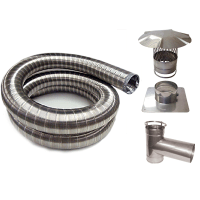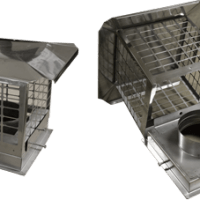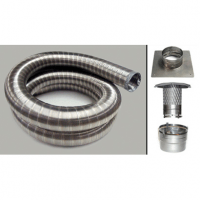No two fireplaces are alike when it comes to smoking chimneys. There are many factors as to why a chimney doesn’t draft properly and your home gets filled with smoke with a down draft.
Chimney Height
Every chimney should abide by the 10ft – 2ft rule. Under normal conditions your chimney should work fine if this rule is met but there are always exceptions. Measure out 10ft horizontally from your chimney to the nearest object (roof line, peak, room addition etc), once you have the 10ft mark go vertically 2ft up and that should be the height of your chimney.
Your chimney should be at the proper height with the stack high enough to catch the wind. Your chimney doesn’t have to rise above the peak unless the peak is within the 10ft clearance. As the wind blows across your homes roof line it should create an updraft bringing the smoke with it.
Sometimes a negative pressure situation might occur where the wind causes a down draft and you may have to look at raising the height of your chimney. Recently some new products have arrived on the market to help ease the cost of raising a chimney.
Flue extenders are a chimney cap that is raised up with long sheet metal sides.They come in stainless steel or copper and have proven to solve many drafting problems. They a relatively inexpensive compared to having a brick mason come out and raise the flue tiles. Another great product are chimney pots. These have been used in Europe for centuries and were usually made of clay.
A new line of chimney pots are made out of copper. The copper chimney pots are expensive but the unique design and the beauty are very pleasing to look at. Copper ages to a beautiful verdigris green after it is exposed to the outdoor elements and will give your home great Curb Appeal.
If you have a metal zero clearance fireplace you will have to get the manufacturers name and the model number off a plate inside the firebox to determine which size and brand pipe you will need to purchase to raise the chimney another 1 – 3ft. Some cities require that the pipe be enclosed in a chase and you might have to rebuild the chase up to the new height. While raising the height of your chimney will solve most of the problems some chimneys may need more help.
Other great products on the market for solving drafting problems are the Vacu-Stack and the Windbeater chimney caps.These chimney caps are designed to create an updraft as the wind blows. The cap itself stays stationary and this causes the wind to circulate creating the updraft. This solution works well with masonry, metal chimneys and even the solid pack chimney pipe for wood burning stoves. They come in several sizes and adaptors are available for masonry chimneys.
With a metal chimney no adaptor is needed. If you have a air cooled chimney pipe one where there are 2 or 3 pipes inside each other just measure the inner one for the cap. The Vacu-Stack for the air cooled, double or triple wall pipe comes with a collar to cover the outer pipes. The Vacu-Stack and the Windbeater caps also come in smaller sizes to fit furnace and hot water tanks to solve their drafting problems.
Another possible simple solution is just adding a chimney cap. many times wind will blow down the chimney creating a down draft. Adding a chimney cap could stop the wind from being able to enter down the chimney.
This article is continued at The Log Rack






